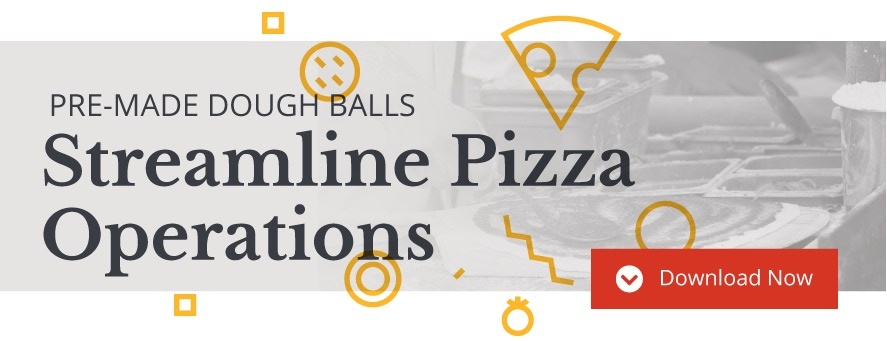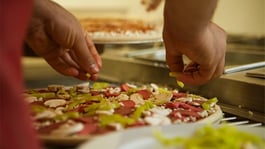
With annual sales exceeding $46 billion (40% of those sales going to independent and small chains), the U.S. pizza restaurant industry continues to prove its strength, even in the wake of a pandemic and economic downturn. According to PMQ’s Pizza Power Report, pizza sales quickly rebounded as the economy reopened post-lockdown and overall, pizza operations fared better than other types of restaurants, seeing sales fall only 0.2%, year over year. In fact, independent pizzerias saw sales rise 0.58% over the previous year.
Even so, certain accelerating challenges are forcing today's pizzeria operators to evaluate how they'll keep growing and increase profit margins this year and moving forward.
Although the following profitability tips cover everything from costs to marketing to operational efficiencies, consider paying specific attention to these top four opportunities.
Keep Tabs on Pizza Profitability Trends
Developing technology
The search is always on for the next advancement that will make ordering/delivering pizzas quicker and easier for the consumer. While smaller, independent pizzerias may lack the capital to invest in pizza-making robots or self-driving delivery vehicles, pizzeria operators should keep an eye open for new, cost-cutting technologies to help boost pizza profit margins, whether that's an ordering app, a labor-saving piece of equipment, or an upgraded POS system.
Easy ordering
Mobile-friendly online ordering increases average check size by 15%, boosts order frequency, improves service speed, and pleases customers. In fact, mobile app usage increased from 51% to 64% in 2021, highlighting the importance of quick and easy access.
Use consistently reliable ingredients widely
No business has been immune to supply-chain vulnerabilities. Savvy pizzeria operators are smart to identify the products they can count on ordering and receiving when they need them, and put those products to work all across their locations. This can also streamline and simplify ordering, which may help address rising costs of shipping and receiving.
Keep specialty ingredients to a minimum
In the pizza business, getting your hands on a four- to six-ounce chicken breast is like finding a four-leaf clover. That means putting specialty ingredients to work in premium menu items only — and operators need to charge customers accordingly in order to make the most of specialty items.
Not everyone wants to dine in
The "quality food at an affordable price" concept that launched fast-casual remains important, yet only 41% of consumers report dining indoors since availability returned. At the same time, 63% of restaurant customers said they'd taken advantage of takeout, and 48% had used curbside pickup.
Evaluate Costs
Delete your hard-copy menu
Given the state of supply chains in the restaurant game, consistently deep and complex menus have gone out the window. Expecting certain products to be available on a regular basis can be a dangerous game. Pizza operators need the flexibility to change menu offerings on the fly, based on what they can — or can't — get.
Increase prices when necessary
Labor and ingredients shortages add up to higher costs. During the early months of the pandemic, both pepperoni and mozzarella were subject to major supply chain disruptions. In fact, considering cost increases as high as 10% for ingredients including produce, dairy, proteins, cooking oil and more, pizzeria patrons should expect to see higher prices on the check.
Seek Out Efficiencies
Believe in ghosts
About 1,500 ghost kitchens — specialty facilities made to support delivery-only restaurant models, which rely on apps and online sales only — sprang up all over the U.S. as a result of the pandemic lockdowns. Given the increased demand for delivery and the overhead costs associated with dining in, it's easy to understand why.
Optimize energy efficiency
Saving on fuel and energy costs can make a significant impact on your business's bottom line and as fuel prices rise, efficiency improvements become even more important to your pizza restaurant's profitability:
-
- Clean and maintain vents, exhaust hoods, gaskets, drainage hoses, and HVAC filters weekly
- Train staff to shut off lights and ovens during non-peak times, keep oven doors closed, and use a programmable thermostat
- Replace traditional light bulbs with the compact fluorescent variety
- Insulate your restaurant’s attic to prevent excess heat exposure
- Take advantage of tax incentives or energy improvement programs your state may offer
Make Marketing a Priority
Target millennials
Reach the generation that wants restaurants to “come to them” by using social media and mobile marketing to promote exclusive offers — like a Twitter-only coupon, for example — and to communicate the basics like your location, hours, menu, reviews, and nutritional information.
Offer smart promotions
Timing is everything, especially when it comes to promotions. Being shrewd about aligning promotions with supply chain management and sourcing analytics helps you launch products successfully and meet increasing demands where you discover them.
When you focus on meeting the moment with trends your customers want and optimizing your pizza restaurant profit margins with operational efficiencies, cost reductions, and marketing opportunities, you can harness your slice of the growth to come in 2022 and beyond.
Expanding pizza operations can boost profits by switching from scratch-made dough to pre-made dough balls. Learn more in our quick-reference infographic on the 5 Ways Pre-Made Dough Balls Streamline Pizzeria Kitchen Operations.
Check out more ways to boost your pizza profit margins with our How to Price Your Pies for Optimum Profit blog.





